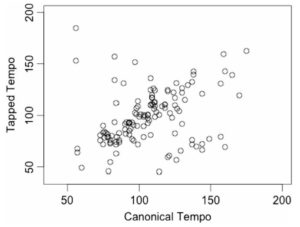It’s close to Christmas. The smell of gingerbread is in the air. The Salvation Army is ringing their bells at every street corner. The sound of “Jingle Bells” is piped onto the sidewalk by your friendly neighborhood department store.
“Jingle bells, jingle bells,
Jingle all the way.
Oh! what fun it is to ride
In a one-horse open sleigh.”
Can you “hear” the tune? Can you whistle or hum along? Probably yes.
And now, having been primed, the tune may keep popping into your mind while you read the remainder of this post. When that happens, you are experiencing involuntary musical imagery (INMI), also known more commonly as an “earworm”.
An earworm has two characteristics: It comes to mind unbidden, without any intention to retrieve or recall the music. Once in mind, it tends to stick around for a while and your mind recycles it without any intent to do so.
Is your mind still doing this?
If so, don’t worry, approximately 90 % of respondents in a large-scale survey recently reported that they experienced INMI at least once a week, and diary studies have identified the median duration of an INMI to be around ½ hour. Only 29 minutes to go.
But how accurate are the mental representations invoked by an INMI? Are they similar to the actual tune or do they resemble the productions of Dude the Dalmatian? A recent article in the Psychonomic Society’s journal Memory & Cognition investigated this issue by measuring the tempo of people’s earworms in real time.
Tempo is one of the principal attributes of music and refers to its pace or speed. Tempo can range from Larghissimo (very slow; 24 beats per minute of the metronome) to Prestissimo (superbly fast; 200 beats per minute or more). In case you need to adjust your current INMI, Jingle Bells clocks in as an Allegretto, with around 120 beats.
Researcher Kelly Jakubowski and colleagues recruited volunteers who reported experiencing earworms on a daily basis. The volunteers were given a diary and a wrist-worn accelerometer.
Participants’ task was to pick a 4-day period of their choosing during which they agreed to tap along to the beat of the music (using the arm with the accelerometer) whenever they experienced an earworm, trying to stay “as closely as possible to what they heard in their head.” The accelerometer recorded their tapping tempo, and participants filled in the diary to record the earworm episode—including details such as the song they experienced and how they felt at the time—as soon as they had finished tapping.
At the end of the 4 days, which netted nearly 300 INMI experiences (or 4 per day on average per participant), the accelerometer data were analyzed and aligned with the diary entries. The primary focus of the analysis was on the accuracy with which participants tapped—that is, how close the tempo of their taps mirrored the tempo of the song at its original (canonical) speed.
The figure below shows the results (in units of beats per minute):

It is evident that notwithstanding the presence of some outliers, there is a fairly strong relationship between the canonical tempo of a song and its tapped tempo. Numerically, the correlation between the two variables was .77, which can be considered substantial. Nearly 60% of songs were tapped within 10% of the original recorded tempo and more than 75% of songs were tapped within 15% of the original tempo. Overall, quite an impressive level of accuracy for an involuntary memory, in particular because this level of accuracy differed little from that observed with explicit imagined recall of music in previous studies by the same authors.
Jakubowski and colleagues examined two more intriguing aspects of their data: First, people’s tapping tempo regressed towards the mean. That is, fast songs were recalled at a slower tempo than their actual speed, and slow songs at a faster tempo than their actual speed. This aspect of the data again mirrors earlier results involving voluntarily imagined songs, suggesting once more that the representations of earworms may not differ much from those that are brought to mind during explicit recall attempts. This overlap between the two forms of representations is quite striking because earworms occur within the context of the external distractions of everyday life: Apparently your memory’s accuracy is unaffected by whether you are trying to recall the tempo of the 1812 Overture (as I have been doing to get Jingle Bells out of my head) or whether Jingle Bells comes to mind unbidden. (Cannons obviously weren’t loud enough.)
The second intriguing aspect of the data by Jakubowski and colleagues relates to the relationship between earworms and one’s affective state. One of the most common uses of music in our society is to regulate our moods: We listen to the 1812 Overture so we can provide an upbeat ending to a blog post, and we may avoid listening to Jingle Bells because it evokes thoughts of unmitigated consumerism and excessive consumption.
Specifically, when listening to music, there is a known relationship between musical tempo and arousal: Listening to a fast tempo can increase subjective arousal, and similarly, a fast tempo is preferred during high-arousal activities such as exercise. Jakubowski and colleagues observed exactly the same association in their data involving earworms: Although the relationship was more modest than is typically observed when listening to music, participants experienced faster tempo earworms when they reported being more aroused.
Jakubowski and colleagues suggest that “INMI might be functionally linked to mood regulation in a similar manner to perceived music. That is, in the absence of an iPod or other music-generating device, spontaneous imagery for music may be able to fill in as a mood regulatory mechanism.”
A spontaneous and unbidden recollection of “Come Home” by Chappo, or any of the other 10 happiest songs, may therefore truly make your day.

1 Comment